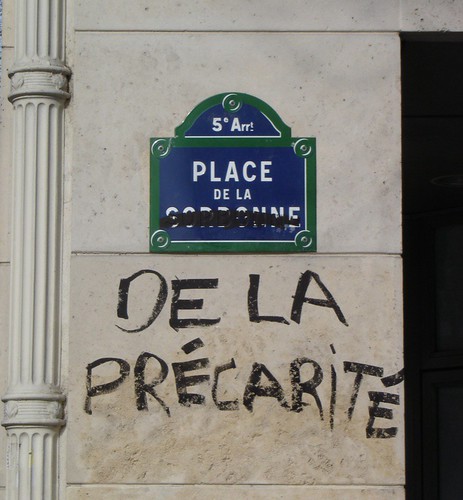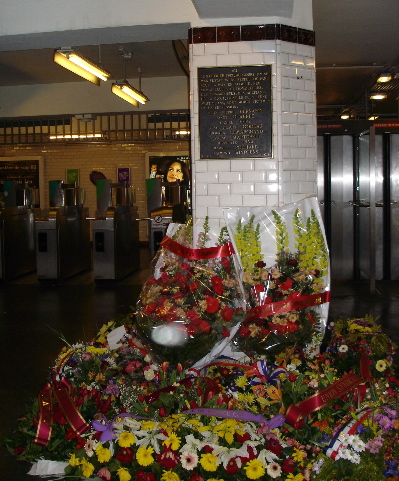11/04/06
Space, time and revolt: - My blog, my project and I, part 2
The working title of my project has been Communities in the making: Identity and belonging in postcolonial Paris and London. Initially, the idea was to do a similar project to the one I had done for my master thesis. However, after I came to Paris I quickly learnt that the situation here is quite different from the one in London 6 years ago. The first thing I realised was that it was no wonder my first fieldwork went pretty well, but – hélas – I yet don’t see any reasons for this one to follow suit…
30/03/06
Demonstrators, casseurs and foreign media
After I had posed the previous text, I realised that I had forgotten to mention that the large majority of demonstrators are peaceful and non-violent, and it’s only at the margins and the end of the demo that the situation can escalate. This fact is obvious to someone who is present at these events or who follows French media, however I have a suspicion that foreign media (again) prefer to show burning cars, hooded youth, teargas and water cannons instead of the one million or three who are demonstrating peacefully.
Les cassurs – the “demonstration breaker” phenomenon
“The demonstrators shall be protected, and the casseurs shall be taken in for questioning,” Interior Minister Sarkozy said some days ago. It’s not the first time Sarkozy has expresses his binary vision of the youth in this country (“real and fake youth”). For a minister in charge of interior security, the world might be this simple, (though I remember how he during the November riots used the to two single cases of attacks on humans to discredit the whole three week and enormously widespread revolt). To me it seems like this broad casseur category hides at least three distinct, but perhaps related phenomena: There are the anarchists and left wing radicals who attack the police (and far right “fachos”, if present). Attacks on publicity boards (JCDecaux) and perhaps also on banks and multinationals (as is common in i.e. the UK) can probably also be connected to this category of casseurs - although in my opinion a distinction should always be kept in mind between attacks on property and on humans (including police officers).
27/03/06
Busy week
It’s been a busy week. While the youth in this country have been blocking and occupying schools and universities – or protesting against those blocking their universities – or been out in the streets demonstrating, burning paper cars or real cars, tagging, breaking a few bus shelters and windows or robbing demonstrators for their mobiles, I’ve been indoors at various prestigious Parisian venues listening to people discussing discrimination.
25/03/06
Mars – “mois chaud”
It wasn’t the climate the newspaper Le Parisien was thinking of when they some weeks ago wrote that March would be a “hot” month. And indeed they were right…
17/03/06
The strange nature of politics in France - Protesting, part 2
One thing that struck me during the November riots was the high level of understanding they were shown in the French public debate. It seemed to me that quite a few who participated in the public discourse quickly interpreted the burning of state institutions, private cars and local companies in the banlieues as – not acceptable, but, yes understandable – expressions with some sort of political meaning. A friend of mine familiar with politics in Germany asked me if no one had demanded the demission of the Interior Minister, as it is he who is responsible for law and order. And in a German context, according to her, three weeks of youths rioting all over the country would have been an obvious sign that he didn’t do his job properly…
08/03/06
Contrat premiere embauche - Protesting à la français
Initially, I hadn’t planned to go to the major demonstration against the CPE ("contract 'first employment'") as it only tangentially touches the focus of my fieldwork (tangentially, as the CPE – Contrat Première Embauche – is part of Prime minister Villepin’s plan for égalité des chances: youth unemployment is high in France and even higher in the Zones sensible which is in need of the equal opportunities). But as the echoes of the chanted slogans reached all the way to my flat – situated at least 20 minutes away from the standard demo route Place de la République/Bastille/Place de la Nation – and I saw the diverted traffic as I leaned out of the window, I realised that the scale of the event made it worth defying the heavy rain and head for Nation.
10/02/06
Métro Charonne, 8 février 1962
“Here, the 8th of February 1962, in the middle of a demonstration for peace in Algeria by the people of Paris, 9 male and female workers; communists and union activists, of whom the youngest was 16 years, were killed in the repression. CGT, PCF.”



